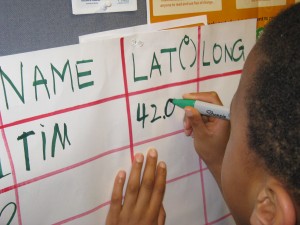Manual Geographic Information System (GIS) Activities

Originally appears in the Spring 2012 issue
Most professions are equipped with tools that enable them to perform their work more effectively and achieve their objectives in an efficient way. In the same way that the microscope and stethoscope are indispensable tools for science and medicine, so are environmental-based technologies indispensable to geography, the environmental sciences and environmental education (Smith, 2005). Environmental-based technologies like remote sensing (RS) and geographic information systems (GIS), when utilized in these subjects, can provide an unmatched learning experience for students. Unfortunately, not many teachers harness these tools in the classroom, usually due to a lack of skills for implementing them, or a difficulty in accessing computer systems, or other necessary digital data and resources (Galloro, 2002).
The purpose of this article is to highlight the importance of GIS and other environmental-based technologies, and offer teachers various ways of using them in the classroom without the hassle of learning GIS software and booking computer rooms. It describes the benefits of GIS and other environmental-based technologies, and provides classroom activities for teachers to utilise. The article also touches on some of the difficulties teachers may encounter when using GIS. Most importantly, the simple non computer-based activities in the article avert some of the systemic issues encountered with computerized GIS. These activities include:
- Using overlays on time-elapsed aerial photography to analyze polar icecap changes
- Using topographic maps and transparency overlays to determine the best site for a mall or a garbage dump
- An additional activity—investigating the extent of damage from a tsunami —can be accessed online at www.greenteacher.com/contents95
To view the photo-rich magazine version, click here.
If you are not already a subscriber, please subscribe to read the full article
Blessing Igbokwe is a teacher with the Greater Essex County District School Board, and a PhD student at the Faculty of Education, University of Windsor in Ontario.
An additional activity—investigating the extent of damage from a tsunami —can be accessed online at www.greenteacher.com/contents95
Leave a Reply
You must be logged in to post a comment.





